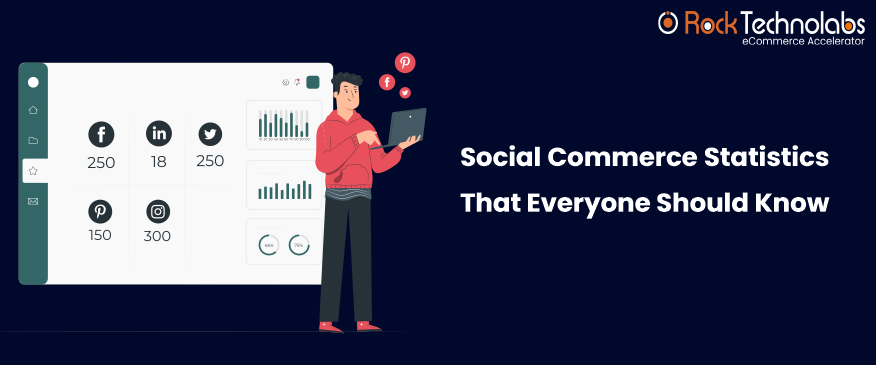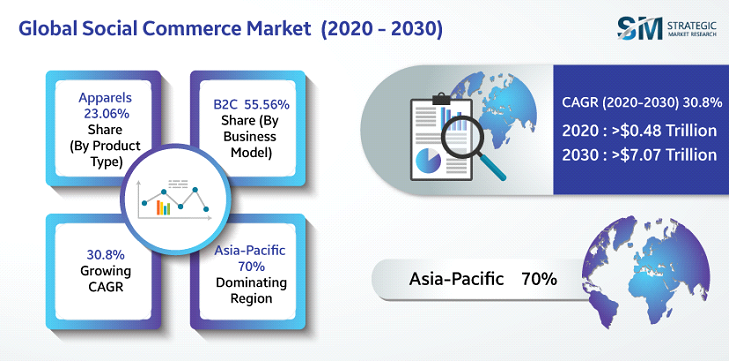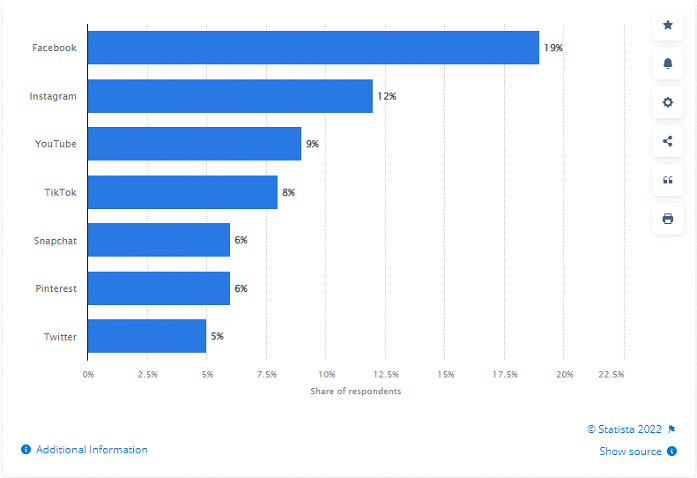Social Commerce Statistics To Know in 2023

Social commerce is a subpart of the continuously escalating ecommerce market worldwide. It is related to creating a hyper-personalised online experience on social media platforms to attract users, and as more and more people have started using social media, brands are focusing a lot more on promoting ads for their products on these platforms, which results in increased sales.
Many businesses are recognizing the importance of social commerce because it works as a very effective method for creating visibility, brand awareness, trustworthiness among followers, quality conversions and help add new customers to their marketing funnel.
There are various advantages of social commerce that attract users towards it; consumers can share the purchase with their family members or friends, it removes the headache of visiting multiple sites to choose a single product, have an easy transaction process, and benefits are not just limited to social media users, the impact of social commerce has generated huge profitability for online and offline merchants.
For businesses, there is no limitation to the target audience’s higher engagement rate while gaining customer loyalty and retention.
According to the research done by Strategic Market Research in their social commerce market report, the global social commerce market is predicted to reach $7.03 trillion by 2030. However, currently, we can say these are early days for social commerce because it has not been decades since social media platform like Facebook, Instagram, Twitter and Pinterest have set their foot to show you what’s going to be the future of social commerce and how it is impacting the online market we have collected some data related to social commerce statistics.

Some Of The Most Significant Social Commerce Statistics That All Businesses And Marketers Should Know
⦁ Rise Of Social Commerce In 2022 & 2026
Social commerce assists in creating a whole ecosystem to drive sales, and according to social commerce statistics, this subsection of ecommerce will rise higher in the upcoming years. In 2020 the estimated global sales using social media platforms were estimated at $560 billion; it has been estimated that the social commerce is going to be at $958 billion in the year 2022, and if the growth continues like this, it could reach up to $2.6 trillion in the year 2026.
⦁ China’s Half Online Users Use Social Channels To Buy Goods
Social ecommerce has indeed gained recognition, but some countries have embraced it highly; one of them is Chinese consumers; in China, approximately half of the internet users have used social networks to buy products in 2021 and social commerce contributed around 13% in China’s online market revenue.
⦁ Social Commerce Has High Influence On Adult Buyers
Social commerce is most attractive for people who are highly active on social networks; basically, buyers aged between 18 and 34. According to the Statista, United States has the second-largest contribution after China in the social ecommerce market as 36 % of U.S. internet users are expected to be social commerce buyers.
⦁ In 2025, 108 Million Consumers Can Purchase Using Social Commerce
More than 22 % of internet users did their shopping via Facebook, and 13% used Instagram to make purchases in 2021. Earlier U.S. was the hub of approx. 79 million online buyers, but U.S. consumers are going to add more to the social commerce statistics in 2025 as 108 million people are expected to purchase through social media channels.
⦁ Facebook Scored Higher By Shoppers
Social Media Channels are an integral part of the social commerce industry, but some are very popular as compared to others, like Facebook, as per the study conducted in mid-2022 unveiled that Facebook is the top social media channel used by online shoppers in U.S and month before this study 19% were reported to use this for online purchase and 12% used Instagram and 9% share went to YouTube.

⦁ Social Commerce With Ecommerce Features To Please The Buyer & Producer
The rise of social commerce brings ecommerce functionalities too, creating an advanced opportunity to connect with buyers that why businesses are taking full profitability of it. In the survey carried out in 2021, in North America, around eight out of ten businesses will use social networks in the next three years. At the time of the study, 57% were already selling through social channels, and around 71% of merchants said to do so in the next 36 months.
⦁ Pinterest Buyers Have The Largest Basket Among All
Pinterest has also launched their new shopping features to find what their users actually want to have, Pinterest shoppers have 30% bigger baskets compared to other social platforms, and 7 out of 10 pinners have said that they surf Pinterest to find new products of their preferred brand due to which they launched verified merchant program, help shoppers to find reliable brands.
⦁ Higher Conversions With YouTube Video Action Campaign
The brand got the opportunity in 2021 to get incremental conversions by showing their ads to the new audience using YouTube ads under video action campaign on TV screens, support to gain 90% of conversion that wouldn’t be possible on mobile and desktop devices.
⦁ Almost 41% of Buyers Become Aware Of Brands Through Facebook
In a survey conducted in NPD’s fashion apparel, half of the buyers agreed to purchase the product they saw in their Facebook and Instagram feeds. In the social commerce market, the shoppers got to know about the brands from Facebook (41%), Pinterest (21%), Instagram (35%), Twitter (17%), Tiktok (15%), and Snapchat (14%), that’s the reason some social media platforms rank higher in user’s preference in addition to other features.
⦁ Dollar Increase By 12 Due To Social Ecommerce
In the second quarter of 2022, the worldwide average value of ecommerce orders via social media channels was $86.2 dollars, resulting in an increase of 12 dollars as compared to the previous year.
⦁ 44% Immediately Makes The Purchase After Viewing
The participating social media users in the survey of 2021 conducted by Statistics said after seeing a product on a social channel, more than half (55%) of them give confirmation of making an online purchase after that, and 44% make the purchase later on, but 11% said they did it immediately.
⦁ With 44% Video Games Have The Huge Share
Video games and accessories accounted for around 44% of all purchases made through social media, followed by toys and hobbies (29%), jewellery and watches (26%), apparel and accessories (25%), and books or audiobooks (23%). One of the biggest examples of video games purchase is Candy Crush (we all have played or familiar with this game); every day made $4.2 million from mobile transactions in 2018.
⦁ 3X Fast Growth Rate Of Social Commerce
According to a new report published by Accenture, from $492 billion worldwide in 2021 to $1.2 trillion in 2025, social commerce is predicted to grow three times faster than traditional ecommerce.
⦁ Half Population Of Adults Prefer Social Commerce Over Traditional Method Of Buying
In the U.S., more than half of the country’s adults make an online purchase using different social media channels, so U.S. social commerce sales are expected to reach $45.74 billion in 2022, and those who are not preference making any online purchase are giving reasons, 44% want to deal with a retailer, unable to trust platform due to filling the payment information, and 33% are not sure about the legitimacy of product they want to buy.
⦁ Increase In Investment For Social Commerce
A survey carried out in the U.S. among chief financial officers of retailers in 2020 in which half of them said they had enhanced their investment in ecommerce in the past six months, and nearly two-thirds of them mentioned that they are planning to support the funding in the upcoming six months and 42 % mentioned a growing investment in social commerce.
⦁ 30% Of Businesses In North America & Europe Are Selling Through Social Media
As per the survey of October 2020, among ecommerce companies in Europe and North America disclose that 30% of them are already selling their products on social media, 20% are not interested in selling directly on social channels, and 12% said they would introduce direct selling through social media in 2021, however, 5% of them were still unaware about the concept.
Social Commerce Examples
The rise of social commerce has opened doors for my businesses to come and rule the market; you can look into some of the great examples in modern times, 100% pure, an organic cosmetic brand that creates its major presence through Pinterest, Milk Bar (Bakery)that got its major section of revenue from Instagram at the time of the pandemic, Instagram also worked as a ladder for Clue’s success (watch and jewellery brand), and there are many more examples, and their success rate defines social commerce growth rate.
Social Commerce is Continuously Booming!
There is too much potential developing inside social commerce that marketers and business owners are using in different ways to sell their products to the target audience; however, still this methodology will take some time to be accepted by all merchants around the world.
Through the above mention data and social commerce statistics, you can estimate how the social commerce industry can massively benefit your business. However, if you are thinking of entering into the world of social commerce, Rock Technolabs can help you as we are an experienced ecommerce development company in Ahmedabad, helping many merchants to establish a brand name in today’s competitive market for national and international clients.


